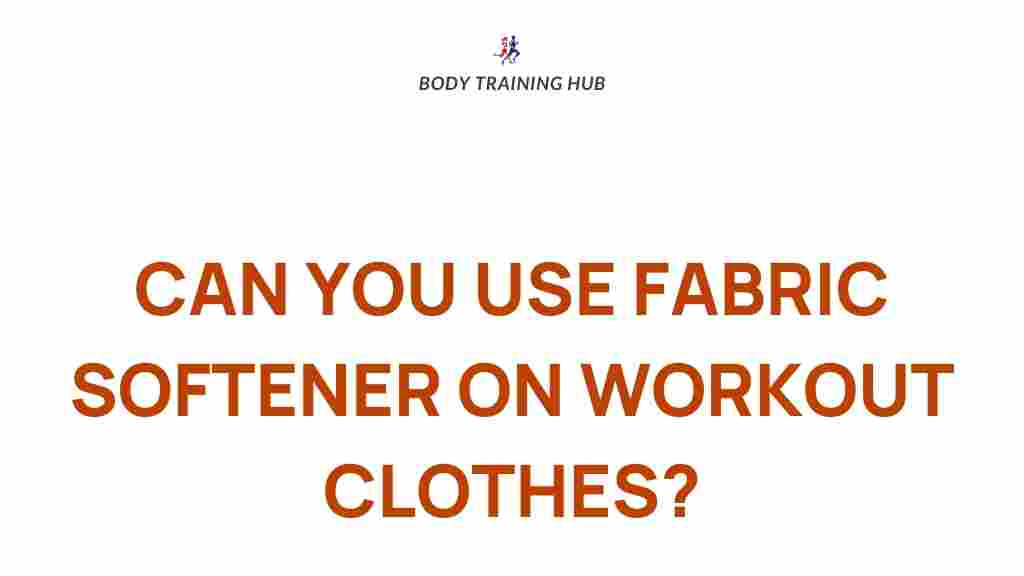Unveiling the Secrets of Fabric Softener on Workout Gear
When it comes to maintaining your workout clothes, fabric softener is often a topic of debate. Many athletes and fitness enthusiasts are unaware of the actual effects that fabric softeners have on their active wear. In this article, we will dive deep into the secrets of fabric softeners, how they interact with sportswear care, and provide essential laundry tips to ensure your workout gear remains in top condition.
Understanding Fabric Softener
Fabric softeners are designed to make clothes feel softer and reduce static cling. They work by coating the fibers of your fabric, which can be beneficial for many types of clothing. However, when it comes to workout clothes, the use of fabric softeners can have both positive and negative implications.
Why Use Fabric Softener on Workout Gear?
There are a few reasons why some people choose to use fabric softeners on their active wear:
- Softness: Fabric softeners can make workout clothes feel more comfortable against the skin.
- Static Reduction: They can help reduce static cling, which can be annoying during workouts.
- Fragrance: Many fabric softeners add a pleasant scent to clothes, making them smell fresh after washing.
The Downsides of Fabric Softener on Workout Clothes
Despite the benefits, there are significant downsides to using fabric softeners on sportswear care:
- Moisture Wicking: Most workout clothes are designed with moisture-wicking technology. Fabric softeners can leave a residue that affects this capability, trapping sweat and moisture against the skin.
- Performance: The added coating from fabric softeners can inhibit the breathability and flexibility of active wear, which are essential for optimal performance.
- Durability: Regular use of fabric softeners can break down the fibers in workout gear, leading to a shorter lifespan of your favorite pieces.
Best Practices for Laundry Tips on Workout Gear
To keep your workout clothes in the best condition, here are some effective laundry tips that focus on proper clothing maintenance without fabric softener:
Step 1: Read the Care Labels
Before washing your active wear, always check the care labels. Each piece of sportswear may have specific instructions that can guide your washing method.
Step 2: Wash in Cold Water
Using cold water is crucial for maintaining the elasticity and shape of your workout clothes. Cold water helps prevent fading and shrinking.
Step 3: Use a Gentle Detergent
Opt for a mild, sportswear-friendly detergent that is free from harsh chemicals and additives. Look for detergents designed specifically for active wear to maintain moisture-wicking properties.
Step 4: Avoid Fabric Softener
As discussed, it’s best to skip fabric softener altogether. Instead, consider using a laundry booster like white vinegar, which can help soften clothes without the negative effects of traditional fabric softeners.
Step 5: Air Dry When Possible
Whenever you can, let your workout clothes air dry instead of using the dryer. This helps preserve the fabric and prevents damage from high heat. If you must use a dryer, select a low heat setting.
Troubleshooting Common Issues with Workout Gear
Even with the best laundry tips, you may encounter some common issues with your active wear. Here are some troubleshooting tips:
Issue 1: Stains
If you get stains on your workout clothes, treat them as soon as possible. Apply a small amount of detergent directly to the stain and let it sit for 5-10 minutes before washing. For tougher stains, consider a stain remover that is safe for synthetic fabrics.
Issue 2: Odor
Sometimes, even after washing, active wear can retain odors. To combat this, soak your clothes in a solution of water and white vinegar (1 part vinegar to 3 parts water) for 30 minutes before washing. This helps eliminate stubborn smells.
Issue 3: Pilling
Pilling occurs when fabric fibers break and ball up on the surface of your workout clothes. To reduce pilling, avoid washing your active wear with rough fabrics like towels, and consider using a fabric shaver to remove any pills.
Conclusion
In conclusion, understanding the effects of fabric softener on your workout clothes is essential for effective sportswear care. While fabric softeners can offer some benefits, the drawbacks often outweigh them, especially when it comes to maintaining the performance and longevity of your active wear. By following the best laundry tips mentioned above, you can ensure your workout gear stays fresh, odor-free, and in peak condition.
For more insights on clothing maintenance and care, check out this helpful resource. And remember, taking the time to care for your workout clothes will pay off in comfort and performance during your fitness journey!
This article is in the category Training Guides and created by BodyTraining Team
